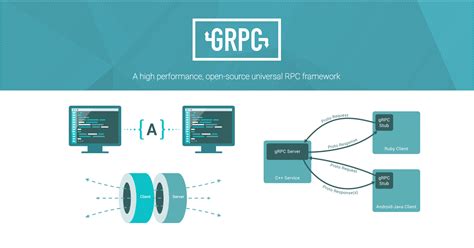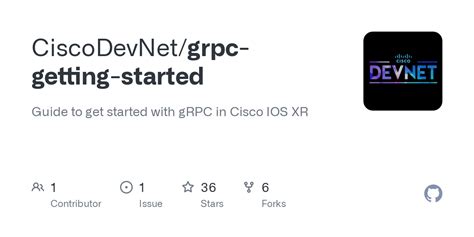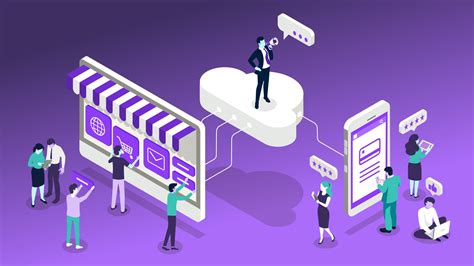Mobile application development has witnessed tremendous growth in recent years, with iOS becoming a prominent platform for developers. One of the key challenges faced by developers during the development process is establishing efficient communication between the mobile application and the backend servers. This is where gRPC comes into play, providing a reliable and efficient means of communication.
Designed to be language-agnostic, gRPC allows developers to establish seamless and high-performance communication channels between different platforms. By utilizing the power of Protocol Buffers, gRPC provides a flexible and scalable solution for data serialization and deserialization, enabling efficient data transmission between the backend servers and iOS applications.
Through the use of gRPC, developers can leverage its secure and lightweight nature to enhance the performance of their iOS applications. With gRPC's support for bidirectional streaming and asynchronous communication, developers can optimize the efficiency of data transfer, ensuring real-time updates and seamless integration with backend services.
In this article, we will explore the various ways in which gRPC can be integrated into iOS applications, taking advantage of its versatility and efficiency. We will delve into the implementation details, highlighting the steps involved in setting up gRPC communication within an iOS application and demonstrate how it can be utilized in real-world scenarios. By the end of this article, you will have a solid understanding of how to leverage gRPC to enhance the communication capabilities of your iOS applications, enabling seamless interaction with backend servers.
What is gRPC?

In this section, we will explore the fundamental concept of gRPC and its significance in the development of iOS applications. gRPC is a cutting-edge technology that enables efficient and reliable communication between client and server applications. It leverages protocols, such as HTTP/2 and binary serialization, to facilitate fast and secure data transfer. By using gRPC, developers can streamline the process of building scalable and high-performance applications for various platforms, including iOS.
One of the key advantages of gRPC is its ability to generate strongly-typed, platform-specific client libraries, which eliminate manual code writing and minimize the chances of errors. gRPC supports multiple programming languages, making it versatile and adaptable for different project requirements. Its lightweight design and efficient network utilization make it an ideal choice for resource-constrained mobile devices like iOS.
With gRPC, developers can define service interfaces and message types using Protocol Buffers, a language-agnostic data serialization format. These protocols enable seamless communication between client and server applications, reducing the complexity and effort required for data synchronization and consistency. Additionally, gRPC provides advanced features such as bi-directional streaming, flow control, and error handling, which enhance the overall performance and reliability of the application.
To summarize, gRPC is a powerful technology that enables developers to build robust and efficient client-server communication in iOS applications. Its support for multiple programming languages, lightweight design, and advanced features make it a preferred choice for building scalable and high-performance applications. In the following sections, we will delve deeper into the implementation and usage of gRPC in iOS development, exploring its core concepts and practical examples.
Advantages of Leveraging gRPC in iOS Development
When it comes to iOS development, incorporating gRPC can bring significant benefits that enhance both the performance and efficiency of your applications. By leveraging gRPC, developers can experience streamlined communication, efficient data exchange, and simplified development processes.
One of the key advantages of utilizing gRPC in iOS development lies in its high-performance capabilities. With its support for Protobuf (protocol buffers), gRPC enables efficient data serialization and deserialization, resulting in quicker communication between the client and server. This improved speed can significantly enhance the overall responsiveness and user experience of your iOS applications.
Another notable benefit of using gRPC is its ability to handle complex distributed systems seamlessly. gRPC supports bidirectional streaming, allowing simultaneous communication between the client and server. This bidirectional communication ensures real-time updates and enables efficient handling of vast amounts of data, which is particularly useful for applications that rely on real-time interactions, such as chat or collaborative platforms.
Additionally, gRPC simplifies the development process by generating client and server code based on specified service definitions. This code generation feature reduces boilerplate code and minimizes the potential for errors, making it easier for developers to focus on implementing business logic rather than dealing with low-level communication protocols.
Furthermore, gRPC offers cross-platform compatibility, allowing iOS developers to seamlessly connect their applications with services running on different platforms. This flexibility enables efficient integration, collaboration, and interoperability between various systems, enhancing the overall scalability and versatility of your iOS applications.
In conclusion, integrating gRPC into iOS development brings numerous advantages, including improved performance, streamlined communication, simplified development processes, and cross-platform compatibility. By leveraging these benefits, developers can create high-performing and efficient iOS applications that deliver exceptional user experiences.
Getting Started with gRPC Integration in your iOS Project

In this section, we will explore the process of setting up the gRPC framework within your iOS project, allowing you to leverage its powerful features for efficient inter-process communication.
To begin, we will guide you through the necessary steps to integrate the gRPC framework into your project, ensuring that you have all the required dependencies and tools in place. Next, we will demonstrate how to configure and establish a connection to a gRPC server, enabling seamless communication between your iOS app and the server.
Furthermore, we will discuss the various authentication methods available in gRPC, such as token-based authentication or SSL/TLS encryption, and provide insights into their implementation within an iOS project. This will help you ensure the security and integrity of your data during communication.
In addition, we will showcase how to define and implement gRPC service APIs within your iOS app, allowing you to expose functionality and efficiently consume remote methods. You will learn how to generate Swift code from your gRPC service definition files, making it easier to interact with the server and handle responses.
Finally, we will address common challenges and best practices when working with gRPC in an iOS project. We will cover topics such as error handling, data serialization, and performance optimization, enabling you to build robust and efficient gRPC-powered applications for iOS.
Creating gRPC Service and Message Definitions
Designing and defining the services and messages in a gRPC framework is a fundamental step in developing robust and efficient communication protocols for iOS applications. In this section, we will explore the process of creating service and message definitions, setting the foundation for a seamless communication architecture.
Defining Services
When it comes to creating gRPC services, it is essential to define the endpoints through which the client and server can interact. By utilizing the gRPC service definition language, developers can clearly specify the available methods, their inputs, and outputs. This definition serves as a contract that both the client and server can rely on, ensuring a smooth and consistent flow of data.
Designing Messages
Messages play a vital role in gRPC communication, acting as the structured data that is exchanged between the client and server. By designing message definitions using the protocol buffer language, developers can define the fields and data types required to transmit information effectively. These messages enable the seamless transfer of complex data structures, providing a flexible and efficient means of communication.
Organizing Services and Messages
Well-organized and modular services and messages are crucial for building maintainable and scalable gRPC applications. By structuring services and messages hierarchically, developers can create a logical and intuitive architecture that enhances code readability and reusability. Understanding how to effectively organize services and messages is key to building robust and extensible gRPC applications.
Conclusion
Creating gRPC service and message definitions sets the foundation for efficient and reliable communication within iOS applications. By carefully designing and structuring services and messages, developers can establish a clear contract between the client and server, enabling seamless data exchange. Understanding the process of creating these definitions is paramount to harnessing the full potential of gRPC in iOS development.
Integrating gRPC Client into Your iOS Application

Incorporating a gRPC client into your iOS application allows for seamless communication and data exchange between the client and server. This section focuses on the implementation of the gRPC client in an iOS application, providing step-by-step guidance on how to integrate this powerful technology into your project.
To start, it is essential to set up the necessary dependencies and frameworks for utilizing gRPC in your iOS application. This involves installing the required software development kits (SDKs), adding the gRPC Swift package to your project, and importing the relevant libraries.
| Step | Description |
|---|---|
| 1 | Install the required SDKs for gRPC in your iOS development environment. This typically includes tools like Protocol Buffers and gRPC Proto Compiler. |
| 2 | Add the gRPC Swift package to your Xcode project using Swift Package Manager, or through manual integration if desired. This package includes the necessary libraries and code for implementing gRPC. |
| 3 | Import the gRPC libraries into your project by adding the appropriate import statements in your source code files. |
Once you have completed the initial setup, you can begin implementing the gRPC client functionalities within your iOS application. This involves generating gRPC client code based on the service definition provided by the server, establishing a connection to the server, and making remote procedure calls (RPCs) to retrieve or send data.
The process typically involves creating a gRPC client object, specifying the server address and port, and implementing the necessary RPC methods based on the service definition. The generated client code handles the underlying network communication and serialization/deserialization of data, allowing you to focus on the business logic of your application.
When making RPCs, you have the flexibility to handle different types of requests and responses, specifying parameters and data formats as required by your specific use case. The gRPC client provides a convenient and efficient way to interact with the server, minimizing latency and promoting secure communication.
Finally, it is crucial to handle error scenarios gracefully when using the gRPC client in your iOS application. This involves implementing appropriate error handling mechanisms, such as handling network connection failures, server timeouts, or invalid responses. By properly handling errors, you can ensure the reliability and stability of your application even in challenging network conditions.
In conclusion, integrating a gRPC client into your iOS application enables efficient and reliable communication with a gRPC server. By following the necessary steps, setting up dependencies, and implementing the client functionalities, you can leverage the power of gRPC to enhance your iOS application's capabilities and deliver seamless user experiences.
Exploring gRPC Streaming in Mobile Development
Experience the power of real-time data communication in your iOS applications with gRPC streaming. This advanced feature allows developers to establish a continuous connection between the client and the server, enabling seamless bidirectional data transfer.
By utilizing gRPC streaming in iOS development, you can create applications that thrive on real-time updates, interactive features, and efficient network utilization. With streaming, your app can constantly receive and send data, keeping users engaged and providing them with dynamic content without the need for continuous manual refreshes.
To implement gRPC streaming in your iOS app, you'll need to understand the underlying concepts of bidirectional communication, server-side and client-side streaming, and how to handle data synchronization. This section dives into the intricacies of working with gRPC streaming and provides you with the necessary knowledge to incorporate this powerful functionality into your iOS applications.
| Key Topics Covered |
|---|
| Bidirectional communication |
| Server-side and client-side streaming |
| Data synchronization techniques |
| Optimizing network utilization |
| Handling real-time updates |
Throughout this section, you'll discover practical examples, code snippets, and best practices for implementing gRPC streaming in your iOS app. By the end, you'll have the necessary knowledge to leverage gRPC streaming and create highly responsive, dynamic, and interactive applications for iOS devices.
Developing iOS Apps with gRPC: Best Practices for Seamless Integration

In the realm of iOS app development, leveraging the power of gRPC can significantly enhance the performance and functionality of your applications. However, to truly maximize the benefits offered by gRPC, it is essential to adopt a set of best practices tailored specifically for iOS development.
1. Efficient Communication: To achieve optimal performance, ensure that your gRPC client and server communicate effectively by employing efficient data encoding techniques and making use of gRPC-specific features such as bidirectional streaming and flow control.
2. Resilience and Error Handling: Build robustness into your iOS applications by implementing mechanisms to handle network failures, retries, and timeouts gracefully. Incorporate gRPC's built-in status codes and error handling capabilities to provide users with informative and actionable error messages.
3. Security and Authentication: Safeguard sensitive user data by leveraging the security features offered by gRPC. Implement secure communication protocols such as Transport Layer Security (TLS) and utilize gRPC's authentication mechanisms, such as token-based authentication, to ensure secure and authorized access to your app's services.
4. Performance Optimization: Fine-tune the performance of your iOS app by employing gRPC's features like compression and caching. Optimize network usage by utilizing gRPC's request and response streaming capabilities and take advantage of its support for efficient data serialization formats.
5. Testing and Debugging: Validate the functionality of your gRPC integration by thoroughly testing your iOS app against various scenarios, including edge cases and error conditions. Utilize gRPC-specific testing libraries and debuggers to identify and fix any issues early in the development process.
6. Documentation and Code Generation: Enhance collaboration and reduce development time by leveraging gRPC's code generation capabilities. Use Protobuf-based interface definitions and utilize tools like the Protocol Buffers Compiler to automatically generate client and server code, facilitating easier maintenance and reducing the chances of integration errors.
7. Version Compatibility: Maintain backwards compatibility between your iOS app and the gRPC services it relies upon. Follow versioning best practices and ensure thorough compatibility testing when upgrading gRPC dependencies or making changes to the app's service interfaces.
Conclusion
Implementing gRPC in your iOS development workflow requires a deep understanding of the best practices specific to the platform. By following these guidelines, you can ensure a seamless integration of gRPC into your iOS apps, boosting their performance, security, and overall user experience.
[MOVIES] [/MOVIES] [/MOVIES_ENABLED]FAQ
What is gRPC and why should I use it in iOS?
gRPC is a high-performance open-source framework that allows developers to build efficient and scalable APIs. It is particularly useful in iOS development as it provides a way to easily communicate between client and server, making network calls more efficient and reducing overhead.
How does gRPC compare to RESTful APIs?
While RESTful APIs are widely used in web and mobile development, gRPC offers some advantages over them. gRPC uses the Protocol Buffers data format, which is faster and more efficient compared to JSON used in RESTful APIs. It also provides features like bidirectional streaming and server-side streaming, which can be useful in certain scenarios.
Can I use gRPC with Swift in iOS?
Yes, gRPC supports Swift in iOS development. You can use the grpc-swift library to integrate gRPC in your Swift projects. It provides generated Swift code for your gRPC services and allows you to make API calls using gRPC client.
What are the steps to set up gRPC in an iOS project?
To set up gRPC in an iOS project, you need to install the grpc-swift library using a package manager like CocoaPods or Swift Package Manager. After that, you can generate Swift code for your gRPC services using the protoc compiler and start making API calls using the generated client code.
Are there any limitations or drawbacks of using gRPC in iOS development?
While gRPC is a powerful framework, it has some limitations in iOS development. One limitation is that it requires the use of Protocol Buffers for data serialization, which may not be suitable for all projects. Additionally, gRPC can be more complex to set up compared to RESTful APIs, especially if you are not familiar with the Protocol Buffers data format.




